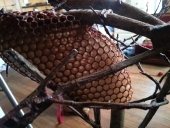posted 11 years ago
Hi Ben,
thats mixed messages.
* small contingent of worker bees - bad situation for the hive to raise a queen
* a couple of queen cells - ok
* no queen to lay an egg - very bad - unless one of the queen cells is already filled with an egg, or a larva.
* bees still busy drawing comb - looks like everything is fine with the hive.
Ok lets start the 'it depends' section.
Do you have another hive, with a laying queen? If yes - take a frame/piece of comb with open brood (and very young larvae) from this hive (make sure, the queen is not with the brood) and give it to the hive in question. If the bees start to draw a queen cell from this larvae - your hive actually did loose its queen, but now they have some brood to raise a new one, thus everything is fine now. If they don't start raising a queen from this piece of brood, they either have a queen wich paused to lay eggs - perhaps due to the package bee process, or are already raising their own queen. Have an eye on them, the (new) queen should start laying eggs in about 2-3 weeks. (There is one bad exception though - if the package arrived without a queen and they are queenless for a longer period of time already, a worker bee may have started laying eggs, in this case you probably find multiple eggs in single cells. In this case the hive is probably lost)
If this is your only hive, (and you can't ask a neighbour for brood) it depends on the presence of eggs or larvae in the hive. If they do have some eggs, or larvae (and the fact that the still draw comb makes this plausible), they will raise their own new queen - no need to introduce a new foreign one. In this case, your (new) queen will start laying eggs in 2-3 weeks (as above). If they don't have this opportunity, they need a queen fast, or a worker bee will start to lay eggs. But a hive with a laying worker bee will not accept a new queen. Introducing a new queen to such a hive is thus a gamble at best.
So I suggest you start a new hive from a fresh package next to you first hive, to be sure you can continue with beekeeping. If your first hive raises a queen you end up with 2 hives. If they don't make it, you can add the worker bees of the first hive to the second hive.
In a hive that is queenless for a longer period (lets say 4 weeks) it often happens that one or more worker start to lay eggs. Such a worker might kill your queen in the second hive. To still join the hives, it is necessarry that the two hives are placed close together to begin with. Close the entrance of the second hive with a queen excluder. Carry the first hive at least 50 feet from their original place and open the hive. Use a lot of smoke that they start filling their honey stomach. After that take a broom and clean the comb from all bees. Take the hive and comb away, so that the bees can't find the hive. The worker bees will take off to fly to their original hive position. The laying workers usually are not so good flyers anymore. Plus they often have a bigger abdomen, so the queen excluder will hinder them to enter the second hive. Normal worker bees on the other hand will enter the second hive and will be accepted by this hive (It helps that they carry honey in their stomach, so use a lot of smoke when starting this process) After joining the worker bees of the two packages, your second hive should develop nicely, since it has almost twice the original number of working bees.
Adding a foreign queen to the seemingly queenless hive is always a gamble. If they have a queen (even if not laying), or are already raising a queen, they won't accept the new queen. If they are hopelessly queenless (have no queen and no brood) but developed egg laying workers, the also won't accept the new queen. Only if they lost their queen, but so recently, that they developed no egg laying workers, they will probably accept a new queen. Thats different with months with an 'r' in their name. In autumn and spring, a hive will more easily accept a new queen.
good luck
Ludger

























 1
1







